


 |  |  |
|---|
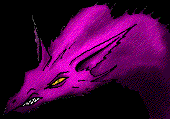 Beasthounds are dog-equivalent pseudoreptiles, having scaly hides interspersed with sparse hairs, a ridge of sharp needle-like spines down their backs (making the act of petting them very hazardous), and muzzles that sport two triangle sets of sharp teeth. They are often employed as guard-dogs, though they are a bit too temperamental (and dangerous) to be used as true pets on any wide basis. Beasthounds are dog-equivalent pseudoreptiles, having scaly hides interspersed with sparse hairs, a ridge of sharp needle-like spines down their backs (making the act of petting them very hazardous), and muzzles that sport two triangle sets of sharp teeth. They are often employed as guard-dogs, though they are a bit too temperamental (and dangerous) to be used as true pets on any wide basis.
| ||
|---|---|---|
| ||
 One of the more distasteful varieties of "fauna" to be found in the jungle regions of the Savan and parts of the plains is the dreaded Blood Fly. These creatures have an uncanny ability to scent blood as far as a mile away, and will arrive in swarms in a matter of minutes (or less). In a sense, they serve as "janitors" of the jungle, But, they are a genuine hazard to wounded creatures. They swarm over fallen victims, blanketing them and cramming into every available orifice, killing by suffocation. After that ... it's just another meal. One of the more distasteful varieties of "fauna" to be found in the jungle regions of the Savan and parts of the plains is the dreaded Blood Fly. These creatures have an uncanny ability to scent blood as far as a mile away, and will arrive in swarms in a matter of minutes (or less). In a sense, they serve as "janitors" of the jungle, But, they are a genuine hazard to wounded creatures. They swarm over fallen victims, blanketing them and cramming into every available orifice, killing by suffocation. After that ... it's just another meal.The best defense against Blood Flies (other than simply never bleeding) is to keep moving. They track by scent, not sight, so even if a swarm is in the same clearing, there is still hope to get moving, and hope to find water. Getting into water is the second method -- On the one hand, washing away blood helps. On the other, Blood Flies drown very easily, and the best way to save a victim covered with the flies is to dunk him quickly. | ||
| ||
 Bromthen Forest-Hogs are found in the jungles on the mountainous edge of the Savan Territories, being very sizeable boar-like creatures with even more sizeable tusks. Full-grown boars easily reach 3 to 4 feet tall at the shoulder, and it is not known just how large their tusks might grow ... it would seem that they simply keep growing until such a point as they are so unseemly that the creature cannot carry its own weight, or else they are chipped and broken during fights. Bromthen Forest-Hogs are found in the jungles on the mountainous edge of the Savan Territories, being very sizeable boar-like creatures with even more sizeable tusks. Full-grown boars easily reach 3 to 4 feet tall at the shoulder, and it is not known just how large their tusks might grow ... it would seem that they simply keep growing until such a point as they are so unseemly that the creature cannot carry its own weight, or else they are chipped and broken during fights. | ||
| ||
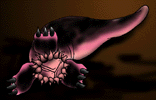 Burrowbits are subterranean creatures that, by appearance, resemble moles with extremely elongated bodies, no hindlegs, and very large foreclaws that act as scoops, capable of burrowing through earth or sand at a remarkably fast pace. Despite the appearance, these creatures are not mammalian. In fact, they are not even vertebrates. They can reach sizes of up to four feet in length. Burrowbits are subterranean creatures that, by appearance, resemble moles with extremely elongated bodies, no hindlegs, and very large foreclaws that act as scoops, capable of burrowing through earth or sand at a remarkably fast pace. Despite the appearance, these creatures are not mammalian. In fact, they are not even vertebrates. They can reach sizes of up to four feet in length. One noteworthy feature of the burrowbit is its ability to store extra food in large sacks that open at its "mouth", and run along the length of its body. It feeds mostly on roots and fungi, and thus these are primarily stored there. If attacked by a predator, the burrowbit follows one of three reactions. First, if it is relatively easy, the burrowbit will simply retreat into its hole and flee. Second, if it is completely cornered, it may attempt to fight, but burrowbits are hardly impressive for their ferocity. Third, however, the burrowbit is capable of contracting its body and forceably expelling the contents of its food pouches and then fleeing. Many times, a food-seeking predator will stop to investigate the expelled food first, before attempting pursuit. This latter tactic, while mostly successful as a last-ditch method, is actually somewhat flawed ... because the Gooshurms seem specially adapted in their behaviors to exploit this feature of the burrowbit. They seek out the small creature during its rare surface excursions, burst out, and whip it with their semi-prehensile tongues. This is usually sufficient to prompt the burrowbit to expel its store and skitter away like the dickens ... while the gooshurm has a snack. | ||
| ||
 Chibix are nocturnal quasi-arthropods that fly on somewhat bat-like wings, and feed on fruits and seeds, found scattered across the globe, though mostly in more temperate climates. They are shelled creatures that bear some remote resemblance to bats, and, indeed, in Rephidim Standard, when one refers to "bats" in the generic, if one is not referring to an Eeee, one is likely referring to one of these creatures. Chibix are nocturnal quasi-arthropods that fly on somewhat bat-like wings, and feed on fruits and seeds, found scattered across the globe, though mostly in more temperate climates. They are shelled creatures that bear some remote resemblance to bats, and, indeed, in Rephidim Standard, when one refers to "bats" in the generic, if one is not referring to an Eeee, one is likely referring to one of these creatures.While chibix wings are very fragile, the creatures themselves are shelled, and have some ability to regenerate (slowly), making them fairly hardy. They tend to be about the size of true bats, though there are rumors that in some regions they may reach truly legendary wingspans. In the Ashdod Territories, they are raised as a food staple by the Eeee. Chibix raised for food have their wings plucked - in part so that they cannot fly away, but also because a flightless chibix generally does nothing but sit and eat, and quickly its fatty hump grows significantly in size. Some Eeee nobles consider it a delicacy to pluck the pry loose the shell of a chibix and eat from its fatty hump, while the creature shrieks loudly, making a "pleasing" sound. Chibix with their wings left intact are sometimes kept as pets, though they are not known for being terribly bright. (And if they misbehave, they make a nice snack.) In myth, chibix often serve as messengers for the Goddess of Secrets, Barada. | ||
| ||
 According to Nagai myth and legend, the Chiga are demonic beings, resembling the serpentine Nagai, but possessing only a single clawed hand (and even this can melt away into the body, leaving the Chiga to look like a true serpent). The Chiga are malevolent and only occasionally "mischievous" beings, possessed of various strange powers, depending upon the story, with abilities such as invisibility, limited shape-shifting (typically into the forms of non-sapient, small creatures), and "phasing" through solid objects. Also according to legend, they are nigh-invulnerable, except when attacked with weapons made from the wood of a slightly rare tree found in the southern Savan, the Thistlebark Tree. According to Nagai myth and legend, the Chiga are demonic beings, resembling the serpentine Nagai, but possessing only a single clawed hand (and even this can melt away into the body, leaving the Chiga to look like a true serpent). The Chiga are malevolent and only occasionally "mischievous" beings, possessed of various strange powers, depending upon the story, with abilities such as invisibility, limited shape-shifting (typically into the forms of non-sapient, small creatures), and "phasing" through solid objects. Also according to legend, they are nigh-invulnerable, except when attacked with weapons made from the wood of a slightly rare tree found in the southern Savan, the Thistlebark Tree. The same name also applies to a type of jungle-dwelling insect (collectively "chigai" or "chigas") to be found in the Savan, well known for attacking the unwary in swarms, capable of bringing down small prey with their bites -- or being a considerable nuisance to larger foes. Sap from the Thistlebark Tree has properties in repelling and killing these pests, leading to much speculation about their relationship to the mythical "Chigai". Alas, it is unknown whether the name for the bug or the "demon" came first. | ||
| ||
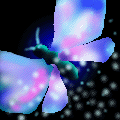 Coolects are small insects that resemble butterflies, which are best known for shedding large amounts of a glitter-like powder for a time after emerging from their shiny cocoons. Coolect powder is used in the making of inks and some other products, though quite a few coolects are required to produce any appreciable amount. Newly hatched coolects are sometimes released at festivities for aesthetic purposes, and are fairly popular with Vartans. Coolects are small insects that resemble butterflies, which are best known for shedding large amounts of a glitter-like powder for a time after emerging from their shiny cocoons. Coolect powder is used in the making of inks and some other products, though quite a few coolects are required to produce any appreciable amount. Newly hatched coolects are sometimes released at festivities for aesthetic purposes, and are fairly popular with Vartans.
| ||
| ||
 Creens are small serpentine lizards with feathered wings and sometimes tail-plumes in bright, festive colors. They are found in many colors and varieties in tropical areas, especially in the jungles. They are found on all of the major continents, not constrained to a particular region. Creens are small serpentine lizards with feathered wings and sometimes tail-plumes in bright, festive colors. They are found in many colors and varieties in tropical areas, especially in the jungles. They are found on all of the major continents, not constrained to a particular region. They are insectivores, and some varieties are capable of being taught to mimic sounds, much like parrots, hence making them somewhat popular as exotic pets for those who can afford them. | ||
| ||
| Drokars are warm-blooded creatures with strongly reptilian features, resembling Terran equines, but with seemingly stylized and elongated features, such as a long, thin and sharply angled muzzle. Unlike reptiles, they sport especially long and wild manes and tufted, leonine tails. They run wild in the plains of the Savan, though they can be found in other regions as well -- even across the sea on the continent of Ur, in parts of Ashdod. Among surface dwellers, they are used as mounts, though on Rephidim they are not found in significant number, since there aren't the wide expanses to justify (or sustain) them, and such beasts of burden as dromodons are more practical for the expense required to maintain them. | ||
| ||
 Dromodons are warm-blooded beasts of burden who have semi-reptilian features, such as scaly hides, and a large hooked bird's beak. They are very solidly-built, and ideal for pulling heavy loads over long treks. They are able to go for long periods without drinking water (and to some degree without eating,) due to fatty deposits that collect on their backs which serve as a "reservoir," especially necessary in their home environment in the Savan, parts of which can be very arid and lacking in readily-available water. Although they originate in the Savan and can be found in the wild there, domesticated strains can be found scattered all over Sinai. Dromodons are warm-blooded beasts of burden who have semi-reptilian features, such as scaly hides, and a large hooked bird's beak. They are very solidly-built, and ideal for pulling heavy loads over long treks. They are able to go for long periods without drinking water (and to some degree without eating,) due to fatty deposits that collect on their backs which serve as a "reservoir," especially necessary in their home environment in the Savan, parts of which can be very arid and lacking in readily-available water. Although they originate in the Savan and can be found in the wild there, domesticated strains can be found scattered all over Sinai.
| ||
| ||
 Eeps are small, flightless birds found primarily in and around the Ashdod Territories on the continent of Ur. They are noteworthy for their wide range of colors, puny bodies, oversized feet, long tailfeathers, and ridiculously oversized eyes. The way that the eyelids pop out to cover the bulbous eyes when the bird blinks is rather startling for anyone close enough to witness ... though anyone who would be disturbed by such a spectacle most likely would not be venturing so close in the first place, given the other habits of the eeps. Eeps are small, flightless birds found primarily in and around the Ashdod Territories on the continent of Ur. They are noteworthy for their wide range of colors, puny bodies, oversized feet, long tailfeathers, and ridiculously oversized eyes. The way that the eyelids pop out to cover the bulbous eyes when the bird blinks is rather startling for anyone close enough to witness ... though anyone who would be disturbed by such a spectacle most likely would not be venturing so close in the first place, given the other habits of the eeps.When disturbed or agitated, the eep will begin to rapidly vibrate, finally emitting an ear-splitting "EEP!" and exploding in a spontaneous self-combustion, sending feathers, bits of bone splinters, and other unpleasant eep elements raining on the nearby area. Oddly enough, nearby eeps will be practically impervious to this, and may go right on without evidencing any notice at all. Eeps have no known predators -- their own suicidal nature keeps the population in check. | ||
| Nagai term used to refer to very young Nagas, typically six inches long or shorter. | ||
 Flickertails are diminutive flying lizard-like creatures with some insect-like features, such as the antennae on their heads, and their insectoid wings. They are most often seen flitting about bushes, hunting insects. At nighttime, they are especially noticeable, as the tips of their tails glow faintly, just enough to attract insects (or a potential mate), though this phenomenon also attracts predators (such as the Chibix). They are found in wooded areas on all the continents of Sinai, and even on some sky islands. Flickertails are diminutive flying lizard-like creatures with some insect-like features, such as the antennae on their heads, and their insectoid wings. They are most often seen flitting about bushes, hunting insects. At nighttime, they are especially noticeable, as the tips of their tails glow faintly, just enough to attract insects (or a potential mate), though this phenomenon also attracts predators (such as the Chibix). They are found in wooded areas on all the continents of Sinai, and even on some sky islands.
| ||
| ||
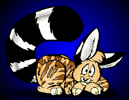 Native to Lamu, but found in many areas all across Sinai, the fuff'nars are very odd creatures. Their appearance can best be described as 'cute'. They are about a foot to a foot and a half long, followed by a ringed tail that is equal to their bodies in length. Fur color is tawny beige, with reddish brown stripes marking their back and legs. Scavengers by nature, they usually travel in small packs and live off the pickings of larger predators. They are capable of bringing down their own prey if their numbers are great enough in a particular pack. Native to Lamu, but found in many areas all across Sinai, the fuff'nars are very odd creatures. Their appearance can best be described as 'cute'. They are about a foot to a foot and a half long, followed by a ringed tail that is equal to their bodies in length. Fur color is tawny beige, with reddish brown stripes marking their back and legs. Scavengers by nature, they usually travel in small packs and live off the pickings of larger predators. They are capable of bringing down their own prey if their numbers are great enough in a particular pack. For some reason, many nobles have taken to procuring fuff'nars as pets. If kept well fed, they've proven to be tame and affectionate -- although if they go for any length of time without food, there's an excellent chance they'll attack their owner. Thusly, when the fuff'nar owmer decides to take the pet for a walk... it's a good idea to keep them muzzled. Fuff'nars have one amazing trait; they can actually mimic a person's voice -- often repeating words said to it by the master. They tend to pick up words relating to their lifestyle and scavenger nature, usually words like "dead" and "kill". | ||
| ||
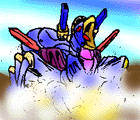 Goliaths are large roaming creatures, a blend of technology and organic beings, accompanied by bands of much smaller creatures known as Zaccis (or Zakis). While they occasionally display high intelligence for a beast, they are generally accepted as being nonsapient -- and typically very violent upon encountering other beings on the Wandering Roams. Goliaths are large roaming creatures, a blend of technology and organic beings, accompanied by bands of much smaller creatures known as Zaccis (or Zakis). While they occasionally display high intelligence for a beast, they are generally accepted as being nonsapient -- and typically very violent upon encountering other beings on the Wandering Roams.
| ||
| ||
 Gooshurms are burrowing worm-like creatures which grow to enormous size, and subsist over nutrients obtained from the soil or sand during their treks. Gooshurms are burrowing worm-like creatures which grow to enormous size, and subsist over nutrients obtained from the soil or sand during their treks.They are primarily found in the Himaat Desert (especially the Sea of Sand), and some can be found in the southern portions of Himar or venturing into the Savan Territories. Legend has it that Gooshurms are inexplicably drawn to foxes, and will pop out of the soil, to lick at the surprised vulpine with their three prehensile tongues, slurping them until they are drenched in worm slobber, before suddenly slipping underground again and zipping along at surprising speeds. | ||
| ||
 Gorts are reptilian creatures that are ape-like in proportions and behavior, found living underground near areas of geothermic activity. (They are, after all, cold-blooded.) Gorts are particularly violent and territorial, and will typically attack any humanoid non-Gort (or any Gort not of their immediate brood) on sight. Although they look humanoid, and sometimes utilize crude clubs for bludgeoning others, no evidence has been found of any language they use, nor that they are even as intelligent as apes. Gorts are reptilian creatures that are ape-like in proportions and behavior, found living underground near areas of geothermic activity. (They are, after all, cold-blooded.) Gorts are particularly violent and territorial, and will typically attack any humanoid non-Gort (or any Gort not of their immediate brood) on sight. Although they look humanoid, and sometimes utilize crude clubs for bludgeoning others, no evidence has been found of any language they use, nor that they are even as intelligent as apes.
| ||
| ||
 Groks are quasi-insectoid "dog"-type creatures domesticated by the Eeee of the Ashdod Territories (and also found running wild in the wilderness). They are completely blind, having no eyes, but have keen senses of smelling, hearing, and are very sensitive to air movements that hint at the presence of prey or intruders. They are reasonably well-armored, with chitinous shells, but are not very bright. Groks are quasi-insectoid "dog"-type creatures domesticated by the Eeee of the Ashdod Territories (and also found running wild in the wilderness). They are completely blind, having no eyes, but have keen senses of smelling, hearing, and are very sensitive to air movements that hint at the presence of prey or intruders. They are reasonably well-armored, with chitinous shells, but are not very bright.
| ||
| ||
 It is a matter of debate whether grooks would be classified as animals, or as golems, since they seem to defy normal definitions of "natural life". They tend to look vaguely like flightless birds, their bodies made up of odd collections of bones and bone-like growths. They do not seem to have any sort of circulatory or digestive system, yet they feed off of the blood of their victims, lending credence to the theory that they are magical in nature. It is a matter of debate whether grooks would be classified as animals, or as golems, since they seem to defy normal definitions of "natural life". They tend to look vaguely like flightless birds, their bodies made up of odd collections of bones and bone-like growths. They do not seem to have any sort of circulatory or digestive system, yet they feed off of the blood of their victims, lending credence to the theory that they are magical in nature. Grooks can sustain the loss of limbs without any apparent ill effects (other than the loss of the use of that limb, of course), but it appears that breaking or removing the "head" will incapacitate a grook, and cause the rest of its body to fall apart. Grooks are found in dark areas, known to have an aversion for bright light, and are primarily found in the country of Kroz in Nordika (northern Ai), though they are sometimes found in neighboring regions (such as southern Gallis and western Olympia). | ||
| ||
| [not common information outside Lamu] Large turtle-like creature found in Lamu, prized by the Lacinus for its meat and remains, as its shell makes good armor, its beak and be used to make a spear, and its eyes harden upon death, then glow when heated up by fire. They mostly dine on Water-Flinger. | ||
| ||
| Female horribs possess the ability to inject a paralyzing, non-lethal form of poison into their prey, so that they can plant their eggs in the still-conscious victim, which will then hatch into larvae and feed upon the host. The Babelites use horribs thus to condemn criminals to a particularly horrible fate, essentially being eaten alive by horrib larvae, and sustained during the whole and quite terrible ordeal. Horribs are also carefully prepared as a delicacy of sorts (since improper preparation can result in poisoned food), and the fleshy tail is especially prized by Eeee diners. | ||
| ||
 Jeebits are particularly malevolent (and small) creatures found in the Wandering Roams (though preferably NOT found if it can be managed). They are no larger than 6 inches in height, though on their surprisingly powerful legs, they are capable of leaping several feet. They capture prey by means of shocking them with their antennae. They also attack creatures they have no intention of preying upon, for all intents and purposes just to be annoying, for all anyone can tell. Despite this malicious bent, they are apparently non-sapient. Jeebits are particularly malevolent (and small) creatures found in the Wandering Roams (though preferably NOT found if it can be managed). They are no larger than 6 inches in height, though on their surprisingly powerful legs, they are capable of leaping several feet. They capture prey by means of shocking them with their antennae. They also attack creatures they have no intention of preying upon, for all intents and purposes just to be annoying, for all anyone can tell. Despite this malicious bent, they are apparently non-sapient.
| ||
| ||
 Kooshkies are strange creatures found in the Sea of Sand that "swim" through the sand at high speeds by means of semi-prehensile flagellate limbs that radiate out from their tiny core bodies. Their means of reproduction and of sustenance is as of yet unknown and defiant of study, as Kooshkies unfortunately do not survive for long in captivity. Kooshkies are strange creatures found in the Sea of Sand that "swim" through the sand at high speeds by means of semi-prehensile flagellate limbs that radiate out from their tiny core bodies. Their means of reproduction and of sustenance is as of yet unknown and defiant of study, as Kooshkies unfortunately do not survive for long in captivity.While they normally travel just under the surface of the sand, they are also capable of leaping considerable distances and bouncing or even rolling along the dunes. They are playful creatures at times, apparently showing affection to each other by bounding into the air and crashing into each other, making a distinctive "koosh" sound when they do so. Otherwise, they are completely silent. Largely, the Kooshkies are prey to various desert denizens, but teams of them may be captured and trained by Nohbakims to draw Kooshkie Sleds. At times, Kooshkie sleds can be seen trailing across the desert, drawn by unseen mounts, with a Nohbakim standing on the sled, cracking a whip in the air and yelling, "Hooska, Kooshkies! Hooska!" The word "Hooska" appears to have no other use in the language of the Nohbakim, and its meaning is not even known for sure by the Nohbakim (though they are never short on opinions). | ||
| ||
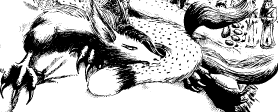 Alternate name: "Blue-Hunter". Alternate name: "Blue-Hunter". A small but fierce carnivore found in the Savan, noted for its large and sensitive ears, long snout, faintly blue-tinged fur, and large claws. These creatures are often hunted for their pelts, but can be trained as pets and guardians. They are not so powerful or resilient as Beasthounds or Groks, lacking thick hides or body armor. However, they are known to fight in a flurry of tooth and claw (mostly claw), sufficient to drive off most enemies twice their size. They're also more favored as pets since they're more easily house-trained than most combat beasts, and tend to be slightly more sociable. | ||
| ||
| Hairy "primate" type of creature with reptilian features, including a long, serpentine neck. Resembles a sloth in some respects, having long arms and grasping claws used for climbing trees. Found in the Savan, especially in Bromthen. Males of the species can swell up their throat, then let out a loud bellow as an alarm or mating call that sounds something like "LOWDY LOWDY LOWDY LOWDY LOWDY LO LO" (hence the name). (The return call from the female sounds like "HUH?") | ||
| ||
 Maws can be described as creatures consisting of a mouth, four little legs, a long tail with a glowing bulb on the end ... and practically nothing else. They are found primarily in the Wandering Roams, but have also been found in various locations in the Savan, and possibly also in small areas of Ur. They range in size from that of a fist to purportedly large enough to swallow a full-sized man (or Khatta or Jupani or...). The glowing bulb apparently helps them to attract insects as prey, but they'll eat anything that they can get their sizeable jaws around. Maws can be described as creatures consisting of a mouth, four little legs, a long tail with a glowing bulb on the end ... and practically nothing else. They are found primarily in the Wandering Roams, but have also been found in various locations in the Savan, and possibly also in small areas of Ur. They range in size from that of a fist to purportedly large enough to swallow a full-sized man (or Khatta or Jupani or...). The glowing bulb apparently helps them to attract insects as prey, but they'll eat anything that they can get their sizeable jaws around.
| ||
| ||
 The Ognoigh is a close relative of the Squibbit, being also found primarily in the Savan, though less often part of the diet of the Nagai. Rather, it is valued more for its peculiar property of changing color when pressure is applied to different parts of its squishy length. The Ognoigh is a close relative of the Squibbit, being also found primarily in the Savan, though less often part of the diet of the Nagai. Rather, it is valued more for its peculiar property of changing color when pressure is applied to different parts of its squishy length. It even retains these properties for a limited time after death, and thus a minor amusement is often made for children by treating oghnoigh bodies to negate toxins in their bodies (but also effectively destroying any nutritional value in the process) and preservatives. Naga children can then slap the oghnoigh bodies silly, producing interesting color patterns, until they "wear out". Oghnoighs can also be fashioned into jewelry before their bodies dry out, and it's a common belief that jewelry will reflect the "mood" of the wearer, since it seems to react to body temperature as well as pressure. This aspect of the ognoigh is exploited mostly in exports. Nagas, after all, are cold-blooded. It is believed that oghnoighs reproduce by breaking off into smaller oghnoighs. Thus, they're built to take a lot of punishment before they're ready to reproduce. | ||
 The Plaguebringers were long thought monsters or weapons of legend, but the War of the Plaguebringers made it painfully clear that they were indeed real, as they descended upon Rephidim. The Plaguebringers were long thought monsters or weapons of legend, but the War of the Plaguebringers made it painfully clear that they were indeed real, as they descended upon Rephidim. While the Plaguebringers are armed to resist most any blow, it was discovered that they have two weak points: their wings, and the "eyes". The pilot resides in a hollow space in the head behind the latter, making him vulnerable to attack. | ||
| ||
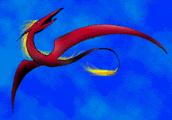 Pteras are winged pseudo-reptilians that can be found over a wide range over Sinai, even more so since they are favored for beast-drawn airships. They are prized for their tolerance of temperature extremes, their exceptional endurance, and also that they can be trained. They can be found "wild" in any number of areas on Sinai, as well as occasionally roosting on the smaller sky islands. Pteras are winged pseudo-reptilians that can be found over a wide range over Sinai, even more so since they are favored for beast-drawn airships. They are prized for their tolerance of temperature extremes, their exceptional endurance, and also that they can be trained. They can be found "wild" in any number of areas on Sinai, as well as occasionally roosting on the smaller sky islands.
| ||
| ||
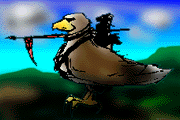 Rahktors are giant avians that are capable of flying at very high altitudes, and can even be found nesting on some of the sky islands, though they are too large to be found "wild" on Rephidim itself. They are large enough to be used as aerial mounts ... or to be very pesky predators capable of carrying off livestock (and people). Some of the Knight Templars of Rephidim utilize Rahktors as mounts, since any assault on Rephidim by external forces would invariably require airborne attacks. Rahktors are giant avians that are capable of flying at very high altitudes, and can even be found nesting on some of the sky islands, though they are too large to be found "wild" on Rephidim itself. They are large enough to be used as aerial mounts ... or to be very pesky predators capable of carrying off livestock (and people). Some of the Knight Templars of Rephidim utilize Rahktors as mounts, since any assault on Rephidim by external forces would invariably require airborne attacks.
| ||
| Razorworms are small, wiggly and quite voracious pests that have a taste for wood, and which live in the Sea of Sand of the Himaat Desert. They are a considerable hazard for sand-ships, as they can find their way through the sand toward wood at a fairly fast pace, and can eat through wood nearly as quickly. The best way to deal with them is by locating bore-holes in an infected ship and dousing the worms with poison as quickly as possible. | ||
| Rotbiters are particularly vicious worm-like creatures apparently native to Abaddon, that dwell in the vegetated canal regions in large numbers. Their bite is almost invariably fatal, inducing a fast-acting wasting disease in victims. Due to their large numbers and voracity, the lush canal regions of Abaddon have been largely left unutilized for many years. Rotbiters were only briefly found in any numbers on Sinai shortly after the "Boomer Incident" in Himar, when Elamoore was displaced by the Red Cliffs. Several Rotbiters were in a section of "canal" that came with the Red Cliffs, and spilled off into the surrounding forests, devastating the local population of Himarian Jupani, before eventually dying off. Rotbiters bear considerable structural similarity to gooshurms, wyrms and even shriken, and may somehow be related. | ||
| ||
| Large domesticated pack animal, primarily found in the plains of the western Ashdod Territories and surrounding areas. Can also be found in farms elsewhere, due to trade with Ur, or sometimes in feral herds in regions without an abundance of predators. Prized for its many uses, as its wooly hair can be used for clothing, its tanned skin as leather, and rughrat milk and meat are a fairly common staple in central Ur and on Rephidim. | ||
 "Sand Fish" bear resemblance to fish, but their classification as such is questionable. These creatures "swim" in the Seas of Sand of the Himaat, and are not known to be found elsewhere. Like the Nohbakim which feed upon them, they demonstrate a very high rate of mutation. They are also highly toxic, such that most would get sick from eating them ... though the Nohbakim experience no ill effects and actually prefer their taste to "normal fish". Sand fish generally have at least three "eyes", though these eyes do not actually have any optical capability (at least, that is known of). They are not known to be able to survive any environment (including air or water) other than the Seas of Sand. "Sand Fish" bear resemblance to fish, but their classification as such is questionable. These creatures "swim" in the Seas of Sand of the Himaat, and are not known to be found elsewhere. Like the Nohbakim which feed upon them, they demonstrate a very high rate of mutation. They are also highly toxic, such that most would get sick from eating them ... though the Nohbakim experience no ill effects and actually prefer their taste to "normal fish". Sand fish generally have at least three "eyes", though these eyes do not actually have any optical capability (at least, that is known of). They are not known to be able to survive any environment (including air or water) other than the Seas of Sand.
| ||
| A spiky ball-shaped creature found in the Sea of Sand of the Himaat. Used as a weapon by the nomadic Nohbakim, hurled via catapults at enemy sand-ships. When the creature is attacked by a predator, it shoots sharp spines from its body. It also does this whenever it is thrown and impacts either the sand or a solid object, making it useful as a "grenade" of sorts, as long as it is handled with great care previous to firing. | ||
| These docile seafaring creatures resemble nothing so much as giant seahorses, typically an orange-gold in color. They can be trained, and used as mounts for seaborne travel. | ||
| ||
 These almost horse-sized, swift-footed lizards can be found in abundance in some areas of the Savan Territories, capable of climbing up the gigantic trees found in the jungle territories, or scaling rocky cliffs. In the cities of the Nagai Empire, they are rigged up to rickshaws (with suction-cup wheels) and used as a fairly reckless means of fast transportation through the urban environment. (May the pedestrian beware!) These almost horse-sized, swift-footed lizards can be found in abundance in some areas of the Savan Territories, capable of climbing up the gigantic trees found in the jungle territories, or scaling rocky cliffs. In the cities of the Nagai Empire, they are rigged up to rickshaws (with suction-cup wheels) and used as a fairly reckless means of fast transportation through the urban environment. (May the pedestrian beware!) One "hazard" that may be encountered by a rider of a selona rickshaw is that, if two male selonas should happen to approach each other head on, they will come to a halt and then start engaging in a head-bobbing contest, trying to look bigger and tougher than each other, much to the chagrin of a driver trying to keep them moving. | ||
| ||
 Seafaring amphibious creatures with reptilian and mammalian features that resemble hippocampae. A serendip's forebody is similar to that of a horse, the front legs forming webbed flippers, while the rear of the body forms into a long tail suggesting that of a dolphin. The head resembles a cross between "dragon" and horse (like that of a drokar), but with more smooth, rounded features, save for fin-like "ear flaps" on each side of the head. Body color varies greatly. Seafaring amphibious creatures with reptilian and mammalian features that resemble hippocampae. A serendip's forebody is similar to that of a horse, the front legs forming webbed flippers, while the rear of the body forms into a long tail suggesting that of a dolphin. The head resembles a cross between "dragon" and horse (like that of a drokar), but with more smooth, rounded features, save for fin-like "ear flaps" on each side of the head. Body color varies greatly. Serendips are used as a means of travel by water, and they have some limited ability to crawl over the land. They are (for the most part) peaceful creatures that can be trained to serve as mounts and pack animals. | ||
| ||
| ||
| | ||
| ||
 Also known as a "sand-shark", this creature is only known to be found in the Sea of Sand in the Himaat, and is believed to be a nasty "cousin" of the less-feared Gooshurm. Shrikens have some slight resemblance to Gooshurms, appearing to be large, segmented, worm-like or serpentine creatures, but their segments appear to be bony, each segment having three bony fins that radiate outward. The head consists of three bony jaws, with no visible eyes, and the mouth contains three flexible tongues which are barbed and secrete a paralyzing toxin. Also known as a "sand-shark", this creature is only known to be found in the Sea of Sand in the Himaat, and is believed to be a nasty "cousin" of the less-feared Gooshurm. Shrikens have some slight resemblance to Gooshurms, appearing to be large, segmented, worm-like or serpentine creatures, but their segments appear to be bony, each segment having three bony fins that radiate outward. The head consists of three bony jaws, with no visible eyes, and the mouth contains three flexible tongues which are barbed and secrete a paralyzing toxin. Shrikens rarely live to grow to full adult size, typically found at no greater than a few feet in length, but there are legends of gigantic shrikens capable of smashing sand-triremes or swallowing victims whole. Some credence is lent to these legends in that the sand-faring Nohbakim often use very large bony structures for the supports for their sand-triremes ...which would tend to suggest the existence of suitably large creatures to provide the skeletons from which these structures are made! | ||
| ||
 Found in the Ashdodite wilderness, these horseshoe-crab-like creatures can be found in greatly varying sizes, for they never stop growing. Their chitinous shells are very hard and covered with sharp, durable spines, and they have segmented, barbed, whip-like tails that are capable of lashing at enemies or even to propel the creature through the air, arcing like a cannonball shot. Found in the Ashdodite wilderness, these horseshoe-crab-like creatures can be found in greatly varying sizes, for they never stop growing. Their chitinous shells are very hard and covered with sharp, durable spines, and they have segmented, barbed, whip-like tails that are capable of lashing at enemies or even to propel the creature through the air, arcing like a cannonball shot.Skedats move about on multiple tiny little legs, and they have larger claws useful for handling prey and for flipping themselves back over if they are upended. They are very disagreeable, capable of making loud screeches that sound like fingernails scraping on slate, only amplified ... and they will charge "intruders" on their "territory". Skedat nests are noteworthy for the silvery sheen of the melon-sized eggs. At first glance, they may be mistaken for metal, because of the high silicon content. "Skedat" is also the name used for a weapon favored by the warriors of Ashdod, fashioned from a skedat shell, hollowed out to cover the hand and part of the forearm, held with a supporting grip. Thus, it serves as a shield and a weapon, what with the sharp spikes. Sometimes the segmented tail is left on, used by more experienced warriors as a barbed whip. "Skedat armor" is made from shells of varying sizes, and it is common for warrior cults of Ashdod to send out young warriors to prove themselves by defeating a skedat in unarmed combat, then to fashion a weapon from the shell. | ||
| ||
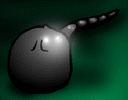 Skuts are a much smaller strain of skedats, covering a much wider range, even found beyond the continent of Ur. In appearance, they are easily mistaken for small, shiny pebbles, especially when they curl their small segmented tails underneath themselves. With a multitude of tiny little claws, they are capable of darting along the ground at a surprising pace. Another feature of the skut is that its claws have small barbs capable of delivering an irritant that can cause severe itching and swelling where they prick skin. Skuts are a much smaller strain of skedats, covering a much wider range, even found beyond the continent of Ur. In appearance, they are easily mistaken for small, shiny pebbles, especially when they curl their small segmented tails underneath themselves. With a multitude of tiny little claws, they are capable of darting along the ground at a surprising pace. Another feature of the skut is that its claws have small barbs capable of delivering an irritant that can cause severe itching and swelling where they prick skin.
| ||
| ||
| Shelled crustacean, vaguely resembling a shark in general shape, found in cold waters, especially in the Northern Sea (also known as the Sea of Ice and the Vykarin Sea). Carnivorous, fast, and highly dangerous, these creatures are nonetheless hunted for their meat and for their shells. | ||
| ||
 Squibbits are small slug-like creatures of unknown classification found primarily in the Savan, used as a cheap food supply by the Nagai and other sapient races of that region -- though not a preferred means of sustenance. The green head of a squibbit is mildly poisonous, but the lumpy "body" can be consumed, leaving the head to regenerate its body over time. They are sometimes used as emergency "rations" on expeditions, since they can subsist off of garbage. Since the squibbit "body" does not squirm as it goes down, it's not preferred by Nagai, and since it doesn't taste all that great, other races tend to avoid it as well if they can afford to. (Squibbits are not a common food source outside of the Savan.) Squibbits are small slug-like creatures of unknown classification found primarily in the Savan, used as a cheap food supply by the Nagai and other sapient races of that region -- though not a preferred means of sustenance. The green head of a squibbit is mildly poisonous, but the lumpy "body" can be consumed, leaving the head to regenerate its body over time. They are sometimes used as emergency "rations" on expeditions, since they can subsist off of garbage. Since the squibbit "body" does not squirm as it goes down, it's not preferred by Nagai, and since it doesn't taste all that great, other races tend to avoid it as well if they can afford to. (Squibbits are not a common food source outside of the Savan.)
| ||
| ||
| [not common information outside of Lamu] Small reptilian domesticated creatures, almost spheroid in shape, tapering at each end into a scrawny neck and diminutive head, and a vestigal tail. They lay blue-purple eggs, which have a reddish-orange filling that is considered a Lamunian delicacy when eaten raw. | ||
| ||
 Vanderats are, in essence, furry velociraptors that come in a wide variety of colorful markings, and which are raised and bred for their speed, found in the lands of the Khattan Emirate of the Himaat. Vanderats are, in essence, furry velociraptors that come in a wide variety of colorful markings, and which are raised and bred for their speed, found in the lands of the Khattan Emirate of the Himaat. Vanderat races are a popular spectator sport in Abu Dhabi, with organized gambling over which ones are expected to win or place. | ||
| ||
 Vermites, also often called "rats" (much to the chagrin of rat-humanoid types) are a type of vermin found in regions across the globe, even in the populated sky-island of Rephidim. In short, they appear to be six-legged rodents with especially scraggly hair. When agitated, their fur fluffs out considerably, making them appear much larger than they really are, although some can grow to appreciable size regardless, sometimes to as much as a foot in length (not counting the furless tail) in certain conditions. (Tales have been told of vermites the size of small dogs, but such reports have not been verified.) Vermites, also often called "rats" (much to the chagrin of rat-humanoid types) are a type of vermin found in regions across the globe, even in the populated sky-island of Rephidim. In short, they appear to be six-legged rodents with especially scraggly hair. When agitated, their fur fluffs out considerably, making them appear much larger than they really are, although some can grow to appreciable size regardless, sometimes to as much as a foot in length (not counting the furless tail) in certain conditions. (Tales have been told of vermites the size of small dogs, but such reports have not been verified.)Vermites thrive on eating just about anything, and can be a hazard, as, in large numbers, they are capable of attacking and killing prey much larger than themselves. In urban environments, though, they are typically skulking, timid little creatures, zipping around and snatching off morsels and generally getting their filthy little bodies into places where they shouldn't be. Vermite exterminators generally have no shortage of work, though it's generally not a pleasant job, requiring going in AFTER the little beasties, into foul environments, and the vermin often carry communicable diseases. Despite this fact, it is not uncommon in poorer quarters for vermites to be captured and cooked up as a very cheap source of meat. (It's said that vermites actually taste almost like rughrat ... but who is going to investigate that claim?) | ||
| ||
 These jellyfish-like creatures are essentially natural gas-bags that float upon the winds, feeding upon whatever bumbles into the grasp of their long stinger- tipped tentacles. This prey mostly consists of some of the exotic airborne plant-life (known collectively as "Sky Gardens") which exhibit similar properties of flight. These jellyfish-like creatures are essentially natural gas-bags that float upon the winds, feeding upon whatever bumbles into the grasp of their long stinger- tipped tentacles. This prey mostly consists of some of the exotic airborne plant-life (known collectively as "Sky Gardens") which exhibit similar properties of flight.The semi-transparent Waashu purportedly gains its name from the sound it makes as it gulps in large quantities of air and then expels it to jet forward with some limited maneuverability. (For the most part, however, it is a slave to the winds.) These gases that it generates and which seep out when it expels air are noxious and somewhat flammable, so while the Waashu may be visually appealing to some at a distance, it isn't nearly so pleasant to approach. Dissected Waashu have no discernable brain or central nervous system, and demonstrate little more intelligence (if any) than plant life. | ||
| ||
| |
| Home Page |
Player Guide |
Log Library |
Recent Logs |
|---|---|---|---|
| Encyclopedia |
Dramatis Personae |
Art Gallery |
Moz Ezley Asylum |